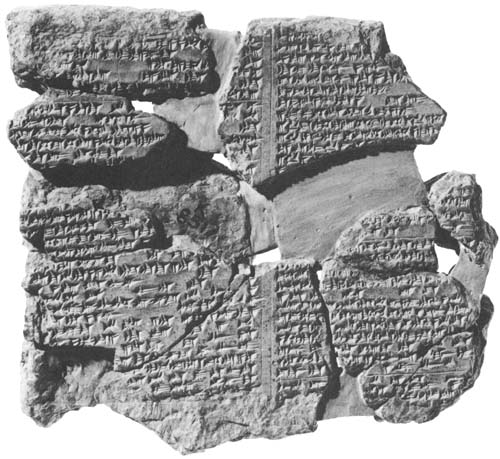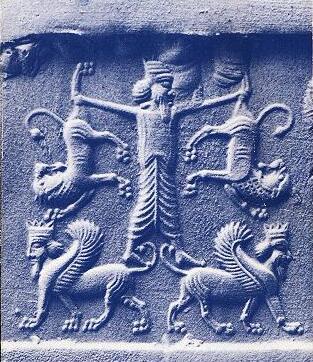This story of a king who was two-thirds God, is a long tale of how Gilgamesh came to defeat everything in his path.The story (probably told orally at first) was written in Akkadian on eleven stone tablets. The words still show traces of the oral format and also contain stories that other cultures have.
The first indication that this was once a story told by people is in the introduction (I'm using the translation given by the Ancient Text Library linked to above)
He who has seen everything, I will make known (?) to the lands.
I will teach (?) about him who experienced all things,
... alike,
This is a classic story teller's beginning. An interesting introduction to get the listeners appetite going and then:
One league city, one league palm gardens, one league lowlands, the open area(?) of the Ishtar Temple,
three leagues and the open area(?) of Uruk it (the wall) encloses.
Find the copper tablet box,
open the ... of its lock of bronze,
undo the fastening of its secret opening.
Take and read out from the lapis lazuli tablet
how Gilgamesh went through every hardship.
Before this, there is a little summary given. The listeners are pretty much hooked. The story teller has told this story a thousand times, but still gives magic to the age-old story.
The Great Goddess [Aruru] designed(?) the model for his body,
she prepared his form ...
... beautiful, handsomest of men,
... perfect
Ok, now the girls really want to listen. The scene being set and the audience hanging on every word, the weaver of tales starts his tale. Every now and again, there are repeating sections to make sure that everyone remembers how much Gilgamesh likes women, or how great he is in battle. This is probably a technique to make sure that listeners remember who this is about and how fantastic the man is.
The teller of the tale also has parts where he seems almost conversational.
But his (Enkidu's) eyes do not move,
he touched his heart, but it beat no longer.
He covered his friend's face like a bride,
swooping down over him like an eagle,
and like a lioness deprived of her cubs
he keeps pacing to and fro.
There is also a lot of description. Some of the descriptive verses can take longer than it does to say what happens. With an oral telling, you need this so that those hearing the tale can picture the scene where the adventures are taking place.
What other tricks do we use, when telling stories, to keep the audience interested?


Something I noticed from looking at the translation you gave is that many lines use the same word phrases, that probably helped the narrator remember what to say. "I must now travel...I must face...and I must travel..."
ReplyDeleteI bet the repeating lines also helped keep the audience engaged, because they would be searching for familiar phrases. I think another thing that a lot of speakers do to keep the audience interested (whether intentional or not) is to use hand gestures and body language.
ReplyDeleteInterestingly, I've never heard of the story of Gilgamesh until now. Does anyone happen to know how long it was "oral knowledge" before it was written on stone?
ReplyDeleteI liked how you mentioned that they had to use so much description in their imagery. The same is for written down knowledge too though, but I think the difference is in art. I don't think they held up a picture and said, "and this is what it looked like".
Madi, I'm not sure what time it began, I have heard that it has been around a couple of cultures though. I know we've talked about it in class before, but haven't found anything on it in the posts. What do you mean the difference is in art?
ReplyDeleteI think Madi means that instead of gestures and the tone of the voice creating images, written language uses art work. If she did mean that, I don't agree with it, but I won't get into written knowledge.
ReplyDeleteWe all use gestures to tell a story. When we talk we use our hands to emphasize something or show that we're excite so the listener should be too.
I don't necessarily mean gestures. I mean actual images; pictures, sculpture. In written and oral stories authors use this; they describe the images, not actually show them. So in the way that Emily pointed out, there is a similarity between oral and written knowledge.
ReplyDeleteOh, I think I see now. I agree, we, as the narrator or author, try and show the audience how we see it in our minds wither with adjectives or gestures. I know we probably won't get around to talking about film as a form of knowledge, but for me that was always the most disappointing part of the movies, you have the story told to more of you senses, instead of just one it takes out the magic and imagination. Which is like not letting me think, just wrong!
ReplyDelete